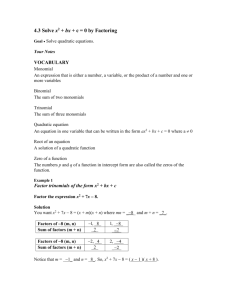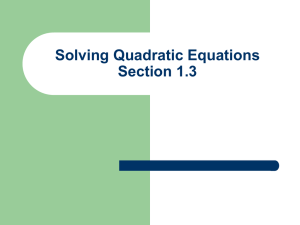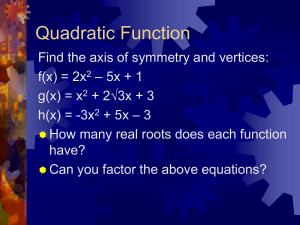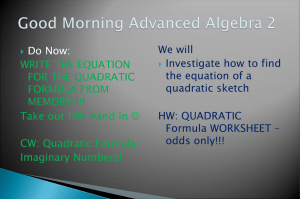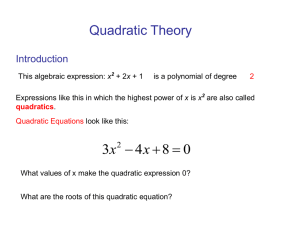Quadratic Formula
advertisement
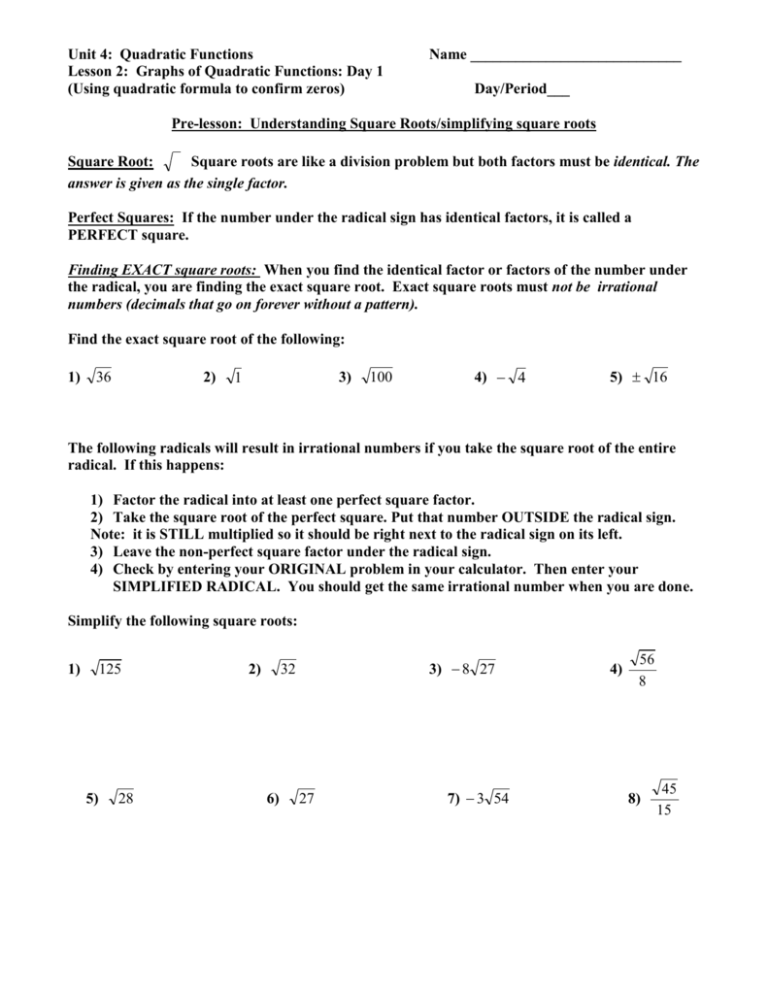
Unit 4: Quadratic Functions Lesson 2: Graphs of Quadratic Functions: Day 1 (Using quadratic formula to confirm zeros) Name ____________________________ Day/Period___ Pre-lesson: Understanding Square Roots/simplifying square roots Square Root: Square roots are like a division problem but both factors must be identical. The answer is given as the single factor. Perfect Squares: If the number under the radical sign has identical factors, it is called a PERFECT square. Finding EXACT square roots: When you find the identical factor or factors of the number under the radical, you are finding the exact square root. Exact square roots must not be irrational numbers (decimals that go on forever without a pattern). Find the exact square root of the following: 1) 36 2) 3) 1 100 4) 4 5) 16 The following radicals will result in irrational numbers if you take the square root of the entire radical. If this happens: 1) Factor the radical into at least one perfect square factor. 2) Take the square root of the perfect square. Put that number OUTSIDE the radical sign. Note: it is STILL multiplied so it should be right next to the radical sign on its left. 3) Leave the non-perfect square factor under the radical sign. 4) Check by entering your ORIGINAL problem in your calculator. Then enter your SIMPLIFIED RADICAL. You should get the same irrational number when you are done. Simplify the following square roots: 125 1) 5) 28 3) 8 27 32 2) 6) 27 7) 3 54 4) 56 8 8) 45 15 Graphing Calculator Review For each quadratic function below, use the graphing calculator to graph the parabola and find the following: a) The zero(s) (if any) (use the Calc>zero and left bound and right bound to find them. b) The intercept (use Calc>Value>x=0) c) The vertex (you can use Calc>minimum or maximum) d) Tell if the parabola opens “up” or “down”. 1) f ( x) 4 x 2 17 x 15 2) y 4 x 2 28 x 40 3) h( x) x 2 6 x 4 a) a) a) b) b) b) c) c) c) d) d) d) Quadratic Formula Sometimes trinomials do NOT factor (or we just don’t want to factor!) but we need to solve them for x when y=0 so we can find the x-intercepts. When this is the case, there are alternative methods to factoring and then using the zero-product property to find zeros. One of the alternative methods is the quadratic formula. Here is the quadratic formula. Remember that formulas are recipes for the answer. You just a) Identify a, b, and c in the equation 0 ax 2 bx c b) Find the value of D, the Discriminant b 2 4ac c) Substitute a, b and the value of D into the quadratic formula d) Find the EXACT answers by simplifying the radical and then the fraction. e) Find the decimal answer(s) by using the calculator. b D b b2 4ac or x where D b 2 4ac x 2a 2a Quadratic Equations will ALWAYS have TWO answers, (the same number of answers as the exponent of x). Algebra Extension Finding zeros mathematically using Quadratic Formula Confirm the x-intercepts by substituting 0 in for y. Then use the quadratic formula to find the a) EXACT ZEROS b) The decimal values of the zeros (these should match the calculator’s answers. x b D b b2 4ac or x 2a 2a where D b 2 4ac 1) f ( x) 4 x 2 17 x 15 a) Identify a, b, c : _________________________ b) Find the value of the discriminant D= b 2 4ac c) Use the quadratic formula and substitute in all values. Simplify the radical if possible and give the two EXACT ZEROS. d) d) Use the calculator and give the two zeros as decimals _______________________ 2) y 4 x 2 28 x 40 e) Identify a, b, c : _________________________ f) Find the value of the discriminant D= b 2 4ac g) Use the quadratic formula and substitute in all values. Simplify the radical if possible and give the two EXACT ZEROS. d) Use the calculator and give the two zeros as decimals _______________________ 3) h( x) x 2 6 x 4 a) Identify a, b, c : _________________________ b) Find the value of the discriminant D= b 2 4ac c) Use the quadratic formula and substitute in all values. Simplify the radical if possible and give the two EXACT ZEROS. d) Use the calculator and give the two zeros as decimals _______________________ Additional solve problems Solve the following equations using the quadratic formula. Find the value of D first. Give EXACT answers in simplified radical form if the radical does not simplify Give the DECIMAL answer using your calculator. 1) 2 x 2 15 x 2 0 2) 4 x 2 18 x 15 0 D= D= EXACT answers: EXACT answers: DECIMAL answers: DECIMAL answers:

